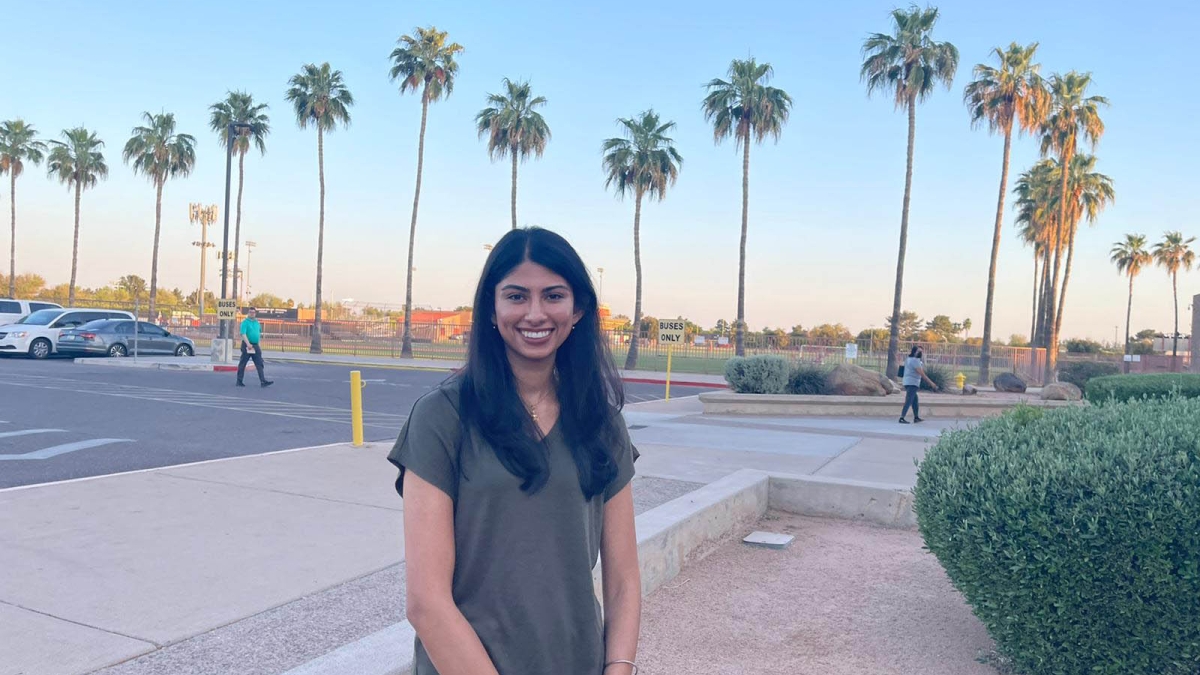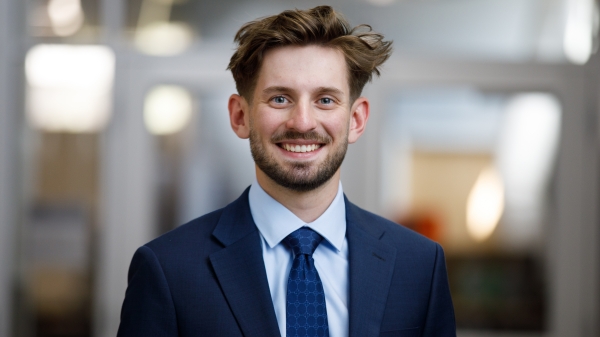Research, initiative, volunteerism define ASU grad's pre-med preparations

Applied biological sciences graduate Nandini Mishra, from Gilbert, Arizona, will complete an accelerated master's in public health next year before starting medical school in fall 2023.
Editor's note: This story is part of a series of profiles of notable spring 2022 graduates.
Knowing early in life that becoming a physician was her calling, Nandini Mishra began volunteering in hospitals as a sophomore in high school to immerse herself in medicine — a field that she said fulfills her desire to give back to the community.
“My heart always feels full when I connect with patients or witness the selflessness of health care workers,” Mishra said, about the rewards of her volunteerism over the last seven years. “Many health care workers have emphasized to me the importance of empathetically and kindly communicating with patients. I’ve seen nurses go out of their way to make patients comfortable in their rooms. I’ve seen physicians give as much of their limited time as is needed to ensure that patients feel heard and understood. Paying attention to humanistic factors has helped me to understand the value of empathy in medicine.”
When she finished high school, Mishra, who is from Gilbert, Arizona, chose to major in applied biological sciences in the College of Integrative Sciences and Arts at ASU's Polytechnic campus, sticking close to home.
“For me, long-lasting relationships are very important to foster,” she said. “Attending ASU allowed me to remain close to family, while also maintaining my independence. ASU and Barrett have a reputable name, and I knew attending this college would help in my medical school journey and building professional connections. ASU also provided a sense of unity and a welcoming feeling, which helped in making my decision.”
She said she feels very fortunate to have had many special career-connected experiences during her time at ASU.
Mishra conducted research and worked on a literature review with a Mayo Clinic medical student and professor, on the topic “Labor and Organ Trafficking Resources for Healthcare Professionals,” which is now a published study in the Journal of Human Trafficking and which she expanded on in her honors thesis.
“We evaluated publicly available, or published educational resources for healthcare professionals on labor and organ trafficking,” she said, “and a poster presentation was submitted to the Arizona Health Equity Conference.”
She said she was inspired to research the subject after realizing there was a dearth of information on the topic.
“I could not understand why such a horrific crime had so little research on identifying victims during healthcare checkups,” Mishra said. “The potential to help the victims and better educate healthcare workers sparked my interest in the subject."
“Through my research, I was able to identify and highlight the lack of proper training for healthcare professionals in identifying and assisting victims. Signs of trafficking are often subtle, and the situations can be dangerous for the victim or healthcare worker,” she said. “There’s a need to create a more robust training program to include a plan of action after identifying markers of trafficking.”
Mishra’s literature review identified that children of Hispanic or Southeast Asian descent are at the highest risk of labor and organ trafficking.
“This fits into the sad theme of exploitation of underprivileged groups of people,” she said. “As a minority myself, this only deepened my passion for creating positive changes that will help the victims.
“I also had the opportunity to be part of the Bidstrup Research Internship, conducting research on the role that human intuition plays for surgeons making risky decisions about their patients’ welfare.”
This plucky pre-med student also pursued hands-on, in-depth laboratory research in the School of Life Sciences’ Cadillo Lab.
“Here, I sampled and analyzed data on the host-phage ecology of Northern Peatlands. The research looked into the DNA of the microbes, using stable isotope probing of Northern Peatland soil. I analyzed patterns of methanogenic communities from peatlands across a vast geographical range,” she said. “Research techniques such as gas chromatography and high-performance liquid chromatography were explained to me, introducing me to a field of science I never knew I held a genuine passion for.”
Natalie Welcome, mathematics instructor in the College of Integrative Sciences and Arts, worked with Mishra on a research project that involved thinking about every phase of the scientific research process, which included considering academic source materials and trustworthy statistical processes.
“Nandini was involved in this self-initiated activity because of her personal interest in gaining new experiences,” Welcome said. “Having demonstrated a strong work ethic and finishing with one of the highest class-averages in my course Calculus for Life Sciences, I was willing to support her request to conduct research.
“With impressive progress made on our completed research project, she proved an ability to simultaneously meet the challenges of coursework and extracurricular activities."
Mishra has been generous in giving back to fellow students. She worked as a peer ambassador in the College of Integrative Sciences and Arts and as a peer mentor in Barrett, The Honors College.
“Being a peer ambassador was extremely rewarding, especially welcoming new students to our campus and community,” she said.
Mishra also took the initiative to share her passion for art, teaming up with her Human Event teacher, Elizabeth Meloy, to found the Barrett Polytechnic Art Club during her freshman year.
The club now has more than 50 members.
“We encourage the exploration of and experimentation with art, regardless of the skill or experience level of members, and provide a space for students to channel their creative minds,” she said. “This club has also served as a social anchor for me and many other members. Every month I would look forward to seeing old faces and making new friends. Art not only helps me unwind, but also has taught me the importance of paying attention to detail, having patience, staying focused and persevering.”
Mishra shared these additional reflections about her ASU journey.
Question: Which professor taught you the most important lesson while at ASU?
Answer: Dr. Natalie Welcome taught me the most important lesson of being true to your morals and ethics. Instead of explaining her philosophy, she embodied it. She was always willing to guide me in my scholarship applications, interviews, essays and was truly invested in my success. She taught me to give back and assist others who are in the position you once were in. Due to her guidance, I will make sure to help younger peers in their academic journey.
Q: What’s something you learned while at ASU — in the classroom or otherwise — that surprised you or changed your perspective?
A: When I took the Human Event class taught by Dr. Elizabeth Meloy through Barrett, The Honors College, I saw that several perspectives can be taken to truly understand culture and history. I experienced paradigm shifts while reading major stories like "Gilgamesh," "The Bhagavad Gita" and "The Nun." Not only had my professor enabled me to open my eyes to a new point of view, but also the class itself allowed me to expand my schema.
Q: What’s the best piece of advice you’d give to those still in school?
A: Pursue a higher-level education. Education is the most powerful tool in today's society and will always support you in life. Education helps in fostering your independent thoughts and shaping yourself. I will also advise you to read as many books as possible, as they teach you many important life lessons. I truly believe books are your best friends.
Q: Did you have a favorite spot at ASU for studying?
A: My favorite spot at ASU for studying was the academic lounge, Barrett lounge or anywhere outdoors at the Polytechnic campus. At the Tempe campus, I enjoyed studying at the Memorial Union, in one of the rooms or Starbucks. These were my favorite spots because of their welcoming atmosphere, and I enjoyed being surrounded by other dedicated and hardworking students who encouraged me to do the same.
Q: What are your plans after graduation?
A: My post-graduation plans are to complete my master's in public health at the University of Southern California, as I am interested in public policy and health care administration. This will be an accelerated course for a year, after which I will be attending medical school in fall 2023.
Q: If someone gave you $40 million to solve one problem on our planet, what would you tackle?
A: I would try to solve the educational barriers present in society. College is expensive and a huge decision for some students based on their financial status. With this money, I would create programs that aid other students in easing the economic burden brought through the hefty price of college. Every student deserves an equal and fair opportunity of receiving a higher-level education; and a financial decision should not be the main reason stopping them from attending.
More Science and technology

Cracking the code of online computer science clubs
Experts believe that involvement in college clubs and organizations increases student retention and helps learners build valuable…
Consortium for Science, Policy & Outcomes celebrates 25 years
For Arizona State University's Consortium for Science, Policy & Outcomes (CSPO), recognizing the past is just as important as…

Hacking satellites to fix our oceans and shoot for the stars
By Preesha KumarFrom memory foam mattresses to the camera and GPS navigation on our phones, technology that was developed for…